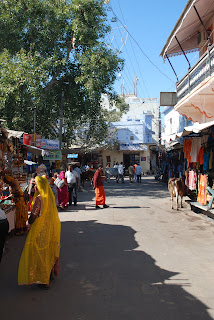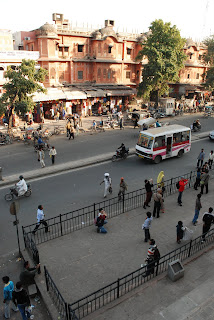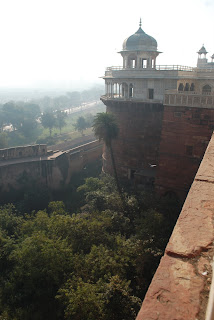
By the time we left Jaipur, we had already completed all three main cities on the popular "Golden Triangle" route. For the last 2 nights of our trip, we decided to head beyond the triangle to the tiny town of Pushkar (see map). This was the part of the trip that made us all nervous. We had read virtually nothing about the city, and what we had read was cryptic. The guidebooks and websites we had read beforehand described the town as the "Holy City of Rajasthan," a place where meat, eggs, and alcohol were prohibited (out of respect to Hindu traditions). The Lonely Planet Guidebook was the most colorful in its description of Pushkar: "A place where people experiment variously with spirituality, marijuana, and facial hair." It seemed like a town that could be either colorful or terrifying.
When we got to the town, our driver had to let us off some blocks from our hotel. You see, in addition to a total prohibition on meat and alcohol, Pushkar also has a visible lack of motorized traffic. Whether this is an attempt at protecting the peace and quiet of the town, or an unintentional side-effect of the city's narrow, pre-modern streets, it certainly does change the atmosphere of the town. In downtown Pushkar, pedestrians don't have to navigate around cars, taxis, or tuk-tuks... just cows, stray dogs, open sewers, and maniacs on motorbikes.



Aside from the affordable trinkets and relaxed pace of life, Pushkar's main attraction is the "Holy Lake" at the center of town. Hindu mythology claims that the lake was formed when a lotus flower fell from the hand of Brahma (the chief deity of the Hindu pantheon). Hindu pilgrims come from all over to bathe in the sacred lake. "Ghats" or small temples, ring the lake, most of which have stairways leading down to the water's edge:
If pressed to account for the time we spent in Pushkar, I would have some difficulty. We slept in
a lot. We ate very long meals. We visited one temple. And, we went for a short hike one afternoon to watch the sun set over the town. Other than that, we mostly just wandered around the town, snapping pictures of scenes from Rajasthani life and haggling with shopkeepers over trinkets. We bought a lot of pottery.
Some highlights of our stay in Pushkar:
 Taking pictures of small-town life from our hotel's rooftop.
Taking pictures of small-town life from our hotel's rooftop. Late afternoon hike to the top of a nearby hill to watch the sun go down:
Late afternoon hike to the top of a nearby hill to watch the sun go down:
 Long lunches in the company of friends:
Long lunches in the company of friends: Rickshaw rides:
Rickshaw rides: Watching the local wildlife from our balcony:
Watching the local wildlife from our balcony: Ok, this last one could use some explaining...
Ok, this last one could use some explaining... We went out for Italian food on our last night in town. The sign at the restaurant's entrance said, "Ask for anything you want... ANYTHING." Obviously my curiosity was aroused. So, when we placed our order, I casually said "I'll have the gnocchi and a beer please." The waiter waggled his head in classic Indian style. Five minutes later, I had a mysterious, foil-wrapped can in front of me. When the waiter left, I carefully peeled back a corner of the foil to discover that I had indeed been served a can of Kingfisher (the ubiquitous Indian lager). Eyeing my frosty beverage with envy, Rus exchanged nods with the waiter. The beer was certainly short of spectacular, but the knowledge that we were breaking the rules somehow made it taste much better.
We went out for Italian food on our last night in town. The sign at the restaurant's entrance said, "Ask for anything you want... ANYTHING." Obviously my curiosity was aroused. So, when we placed our order, I casually said "I'll have the gnocchi and a beer please." The waiter waggled his head in classic Indian style. Five minutes later, I had a mysterious, foil-wrapped can in front of me. When the waiter left, I carefully peeled back a corner of the foil to discover that I had indeed been served a can of Kingfisher (the ubiquitous Indian lager). Eyeing my frosty beverage with envy, Rus exchanged nods with the waiter. The beer was certainly short of spectacular, but the knowledge that we were breaking the rules somehow made it taste much better.
Our flight home from India was scheduled for midnight on a Saturday evening. We checked out of our hotel in Pushkar at around 10 that morning, and made the long (8 hours) drive back to Delhi. The car ride was long but uneventful, and we made it to Delhi at around 7pm. This left 5 hours to kill in the airport (after having spent 8 hours in a car). Boredom set in fairly quickly. To pass the time, our friend Mel grabbed the camera and led us in a little game. She would outline a set of imaginary circumstances, and we would make faces to match that scenario:

As always, feel free to comment on whatever you like. A special challenge for those of you who are having a hard time coming up with a comment: What was the imaginary scenario that caused us to make the faces in the above picture?















































